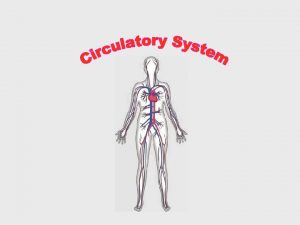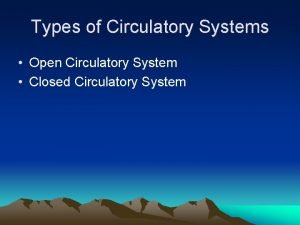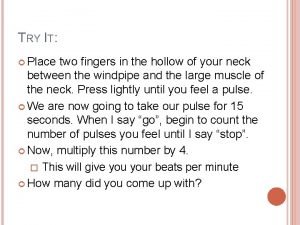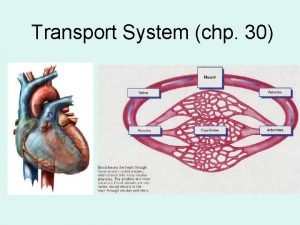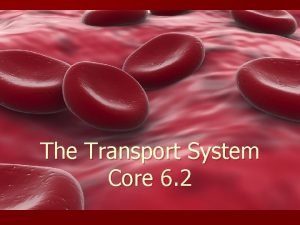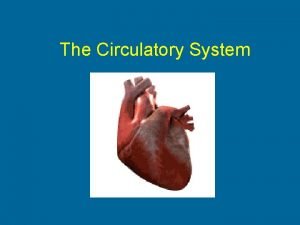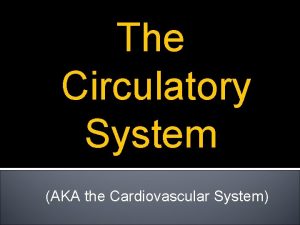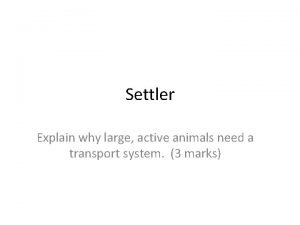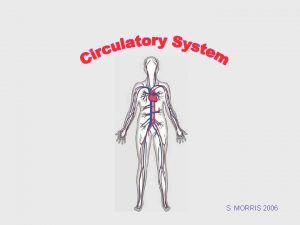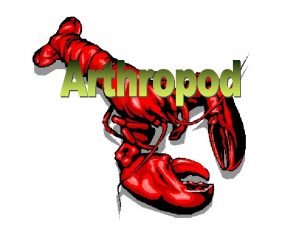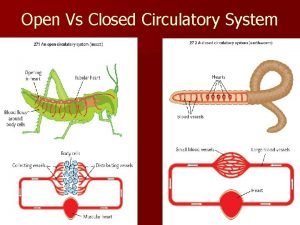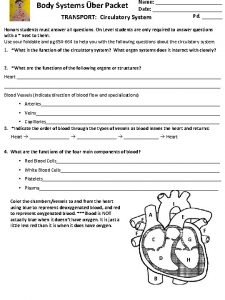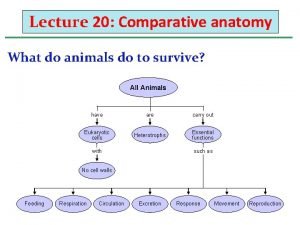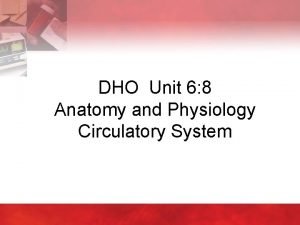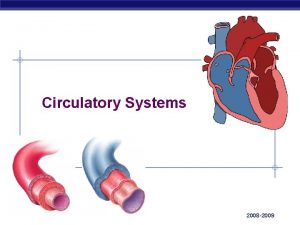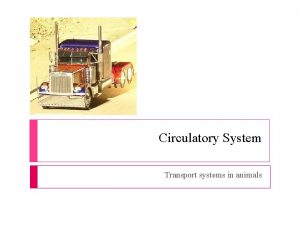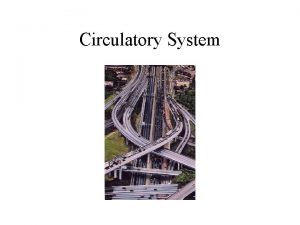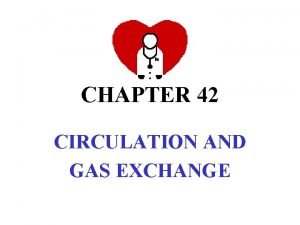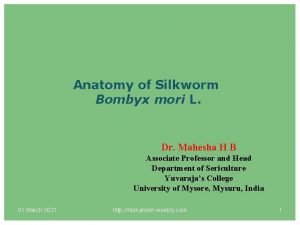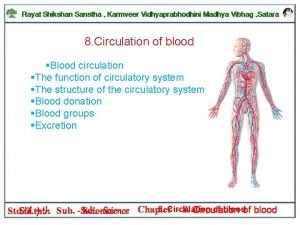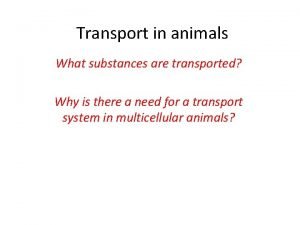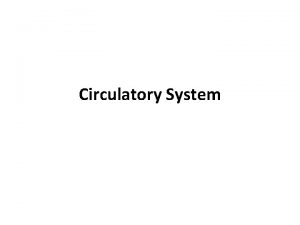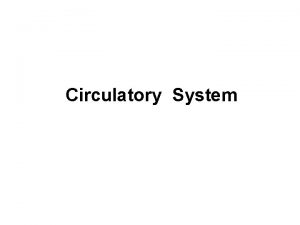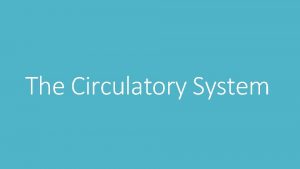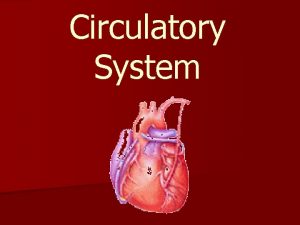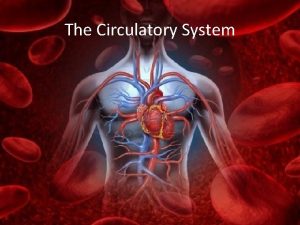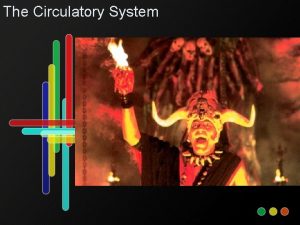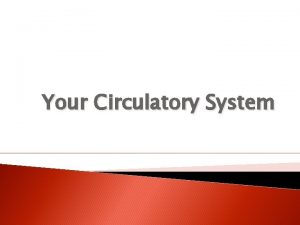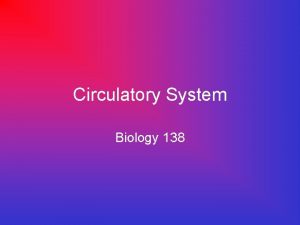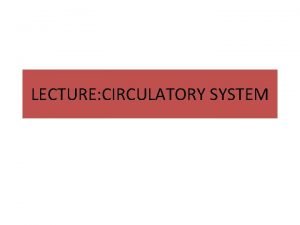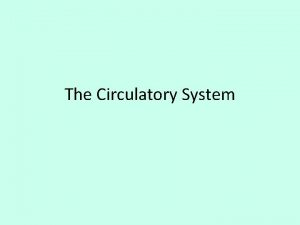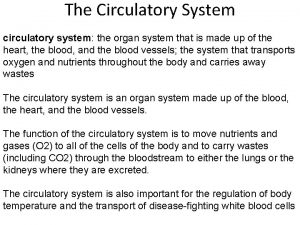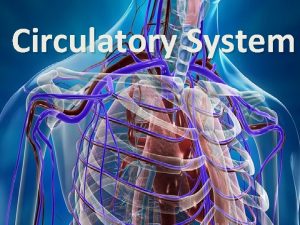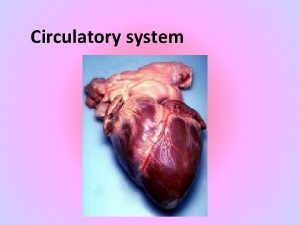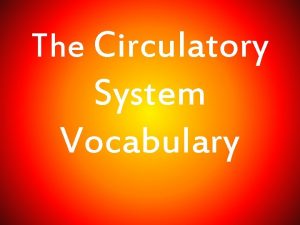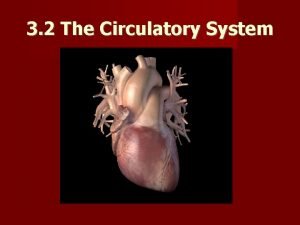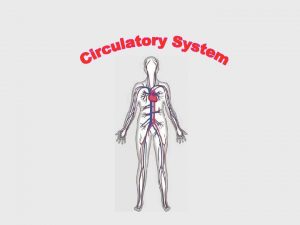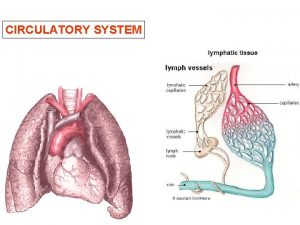The Circulatory System An Overview of the Circulatory


































- Slides: 34

The Circulatory System

An Overview of the Circulatory System ► Check Web!! ► How out how the heart works on the Heart Works

Where the Heart is located

Circulatory or Cardiovascular System ► Circulatory System – Keeps the body working by delivering oxygen to body cells and removing waste (Co 2) from the cells. Delivering Removing

Parts of the Circulatory System ► The Heart - is divided into FOUR Chambers

Two types of Arteries ► Arteries start with A takes blood away !! ► Aorta – Largest blood vessel in the heart ► Pulmonary Artery – Carries blood containing carbon dioxide from your heart to your lungs

Three Types of Veins ► Veins start with V brings blood back to me § 1. Inferior Vena Cava – Where the blood enters the heart from the body. § 2. Superior Vena Cava – Where the blood enters the heart from the body. § 3. Pulmonary Vein – Carries blood-containing oxygen from your lungs to your heart.

The Four Valves of the Heart ► Tricuspid Valve – Lets the blood fill in the right atrium before it enters the right ventricle. ► Bicuspid Valve – Lets the blood fill in the left atrium before it enters the left ventricle

The Four Valves of the Heart Right Semi lunar Valve. Lets the right ventricle fill before releasing the blood into the pulmonary artery. ► Left Semi lunar Valve – Lets the blood fill in the left ventricle before sending it to the aorta ► Septum – Divides the heart in half ►

Three Kinds of Blood Vessels ► Arteries – Carries blood away from the heart ► Veins – Carries blood back to the heart ► Capillaries – Delivers low-oxygen blood to veins (Smallest)

Video of the Valves of the Heart ► The Valves of the Heart

Parts of the Blood ► Red Blood Cells – Made in bone marrow; carries oxygen, food, and rids body of CO 2 and Waste ► White Blood Cells – Help fight disease and infection by destroying bacteria and germs that enter the body. Made in the lymph nodes

Parts of the Blood ► Platelets – Help blood to clot, to prevent excess bleeding. ► Plasma – Water portion of the blood; 55% of blood is plasma

Four Types of Blood ► Type A: 42% Accepts A and O ► Type B: 10% Accepts B and O ► Type AB: 3% Accepts AB and O ► Type O: 45% Universal Donor ► RH Factor = is the + and – of the blood

Four Filters of the Blood 1. Liver 2. Kidneys 3. Lymph Nodes – located in the neck 4. Spleen – Cemetery for the red blood cells

How Blood Moves Through the Heart

How Blood Moves Through the Heart

Blood Disorders Blood Pressure: (Hypertension) The force or pressure developed by the heart, which acts to pump blood through the circulatory system.

Blood Pressure Two Distinct pressures that are measured!! Systolic: A measure of the maximum force or pressure developed in the arteries when the heart contracts Diastolic: A measure of the lowest pressure, which occur in the arteries during cardiac relaxation.

Blood Pressure High Blood Pressure: Continuous elevation of blood pressure above the normal range. Ex. 140/90

Blood Pressure ► Sphygmomanometer: An instrument used to measure blood pressure. ► Stethoscope: An instrument used to listen to the sounds of the heart, or listen to the flow of blood through the vessels when measuring the blood pressure.

High Blood Pressure Video ► Health Animations - High Blood Pressure

Arteriosclerosis ► Arteriosclerosis: Artery walls harden; caused by a diet high in fat and cholesterol. ► Causes: § § § Smoking Diabetes High Blood Pressure High Cholesterol Overweight

Arteriosclerosis ► Arteriosclerosis - We will watch how arteriosclerosis builds up on the walls of an artery. - Overview of the Circulatory system. Overview of the Circulatory System

Arteriosclerosis ► Prevention: § Reduce the amount of stress in your everyday life § Change diet to reduce the amount of sodium, fats and cholesterol. Regular Medical checkups ► Treatment: § Medication § Exercise

Diseases and Disorders of the Circulatory System ► Heart Attack: Stoppage in the flow of blood to the heart. ► Prevention: § Reduce Stress § Change Diet to less intake of Sodium (Salt) § Eat less foods high in fat and cholesterol

Diseases and Disorders of the Circulatory System ► Anemia: Lack of red blood cells or cells that do not carry enough oxygen; may cause weakness and low energy levels. ► Prevention: § Eat foods that are rich in Iron § Treatment: Rest

Diseases and Disorders of the Circulatory System ► Sickle Cell Anemia: ► Normal Blood Cell Your blood is unable to circulate properly. ► There is no prevention for sickle-cell anemia since you are born with it. ► Sickle Cell ► Treatments: § Blood Transfusions § Medication

Diseases and Disorders of the Circulatory System ► Mononucleosis: A viral infection; with symptoms of sore throat, swollen glands and fatigue. ► Prevention: § Avoid human saliva ► Treatment: § Bed Rest

Diseases and Disorders of the Circulatory System ► Leukemia: Abnormal white blood cells § In time they may crowd out normal white blood cells, red blood cells, and platelets.

Diseases and Disorders of the Circulatory System ► Stroke: Happens when a cluster of blood cells blocks blood vessels in the brain. ► Stroke is a “Brain Attack”

Diseases and Disorders of the Circulatory System ► Prevention: § Don’t Smoke § Drink in moderation (21) § Get cholesterol checked § Exercise 30 minutes daily § Consume a low fat diet ► Treatment: § Medication § Rehabilitation

Diseases and Disorders of the Circulatory System ► Hemophilia: Blood does not clot properly ► Prevention: § No prevention, you are born a hemophiliac ► Treatment: Transfusions of blood clotting factors.

Diseases and Disorders of the Circulatory System ► Kidney Failure: The inability of kidneys to function, resulting in accumulation of fluid and waste products in the body. ► Picture is graphic!!
 Respiratory digestive and circulatory system
Respiratory digestive and circulatory system Tiny air sacs at the end of the bronchioles
Tiny air sacs at the end of the bronchioles Circulatory system and respiratory system work together
Circulatory system and respiratory system work together Circulatory system steps in order
Circulatory system steps in order Single loop circulatory system
Single loop circulatory system Circulatory system of lungfish
Circulatory system of lungfish Clam open circulatory system
Clam open circulatory system Sheep circulatory system
Sheep circulatory system Circulatory system function
Circulatory system function Closed circulatory system
Closed circulatory system Parts of circulatory system
Parts of circulatory system 3 main parts of circulatory system
3 main parts of circulatory system Active animals
Active animals How circulatory system work
How circulatory system work What makes up the cardiovascular system
What makes up the cardiovascular system Gas exchange oxygen transport
Gas exchange oxygen transport Single vs double circulatory system
Single vs double circulatory system Arthropods respiratory system
Arthropods respiratory system Closed circulatory system
Closed circulatory system Arteries and veins difference
Arteries and veins difference Circulatory system foldable
Circulatory system foldable Invertebrate circulatory system
Invertebrate circulatory system Respiratory system fetal pig
Respiratory system fetal pig Unit 6:8 circulatory system
Unit 6:8 circulatory system Open circulatory system
Open circulatory system Open circulatory system
Open circulatory system Circulatory system function
Circulatory system function Two functions of the circulatory system
Two functions of the circulatory system Arthropods circulatory system
Arthropods circulatory system Difference between open and closed circulatory system
Difference between open and closed circulatory system Chapter 34 section 2 the respiratory system
Chapter 34 section 2 the respiratory system Kinetic skull meaning
Kinetic skull meaning Circulatory system of silkworm
Circulatory system of silkworm Function of the circulatory system
Function of the circulatory system Open circulatory system vs closed
Open circulatory system vs closed



